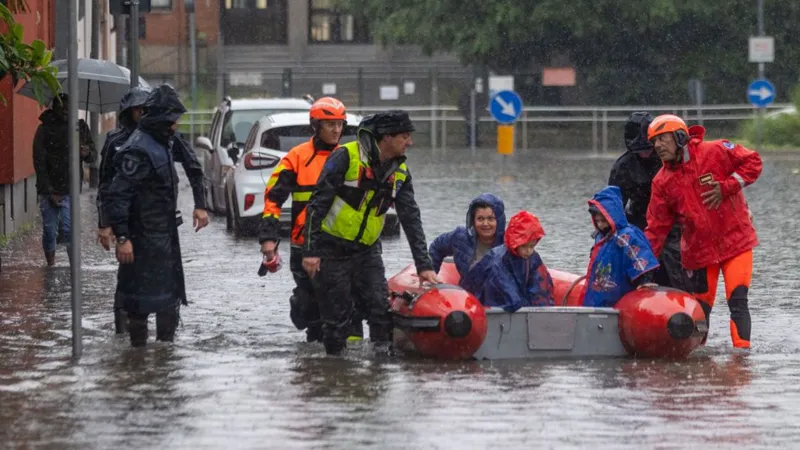Storms and heavy rainfall have inundated many areas of northern Italy, particularly affecting cities like Padua and Vicenza.
Emergency services have been employing dinghies to rescue residents trapped in their homes, and images from the scene depict submerged cars floating through the streets.
The governor of the Veneto region likened the overnight weather to a “water bomb.”
Meanwhile, southern Italy is grappling with an unseasonable heatwave, with temperatures soaring up to 35C in Sicily.
Speaking to the Corriere del Veneto newspaper, Professor Marco Marani, an expert on climate change impacts at the University of Padua, stated, “Extreme events are becoming more frequent and will increase with the rise in global warming.”
During the early hours of Friday, heavy rain caused the banks of the Muson dei Sassi river in the Padua area to breach, leading to significant flooding.
In Lombardy’s Borgo Mantovano, a freight train was overturned by gusts reaching between 150 and 200km/h (93-120 mph).
Local mayor Alberto Borsari took to social media, reporting that “many streets and basements were flooded,” and describing the situation as “really tough.” He added, “Luckily no-one was hurt.”
Milan experienced up to 130mm (5in) of localized rainfall in a single day, resulting in flash floods. Observers noted that such rainfall intensity hadn’t been seen in May for over 170 years.
In Veneto, a red alert has been declared until 14:00 local time (12:00 GMT) by Civil Protection authorities, particularly between Vicenza and Verona, where water basins are overflowing after 70mm of rain in 30 minutes.
One person is reported missing in the Como area following the collapse of a small bridge.
In the south, Sardinia is facing very dry conditions, exacerbating an already challenging season for local wheat farmers, who anticipate a harvest half the usual size due to water scarcity, as reported by local newspaper L’Unione Sarda.
Water restrictions are anticipated in the area later in the summer.
Professor Marani stressed the need for updating calculations for water defenses to comprehend the actual risks posed by climate change. “Climate change must be managed,” he emphasized.
In April, the new State of the Climate report by EU climate agency Copernicus and the World Meteorological Organization underscored the necessity for flood defenses and the urgency of climate action. Climate scientists revealed that in 2023, one-third of rivers across Europe surpassed the “high” flood threshold, while 16% exceeded the “severe” mark.









